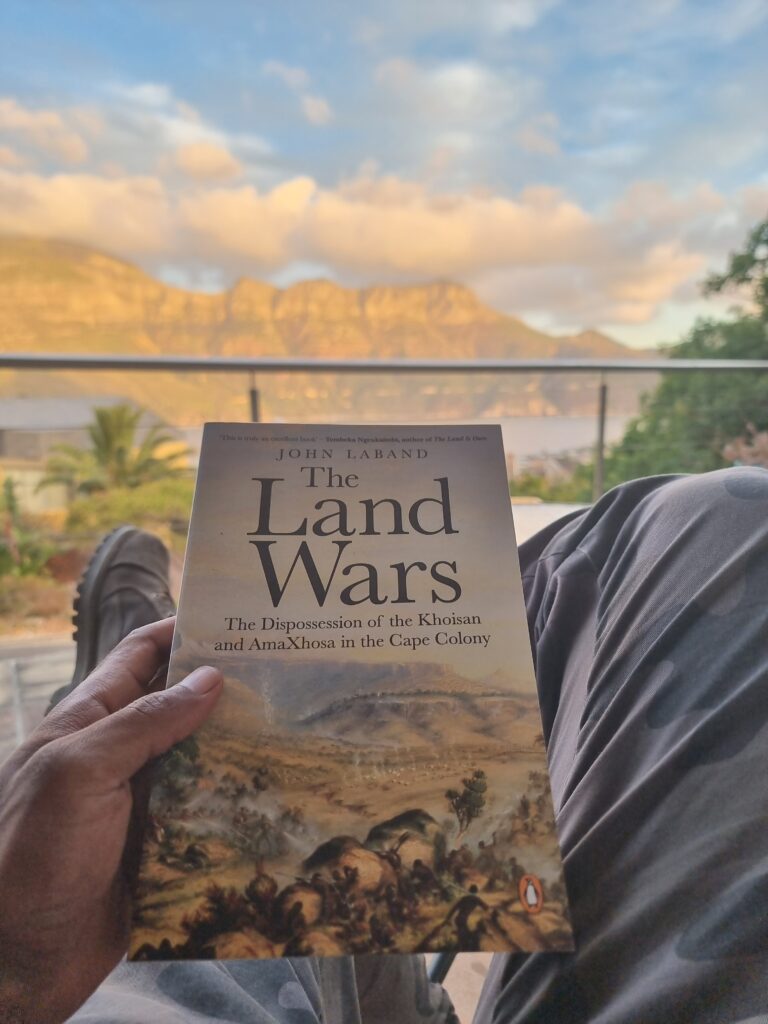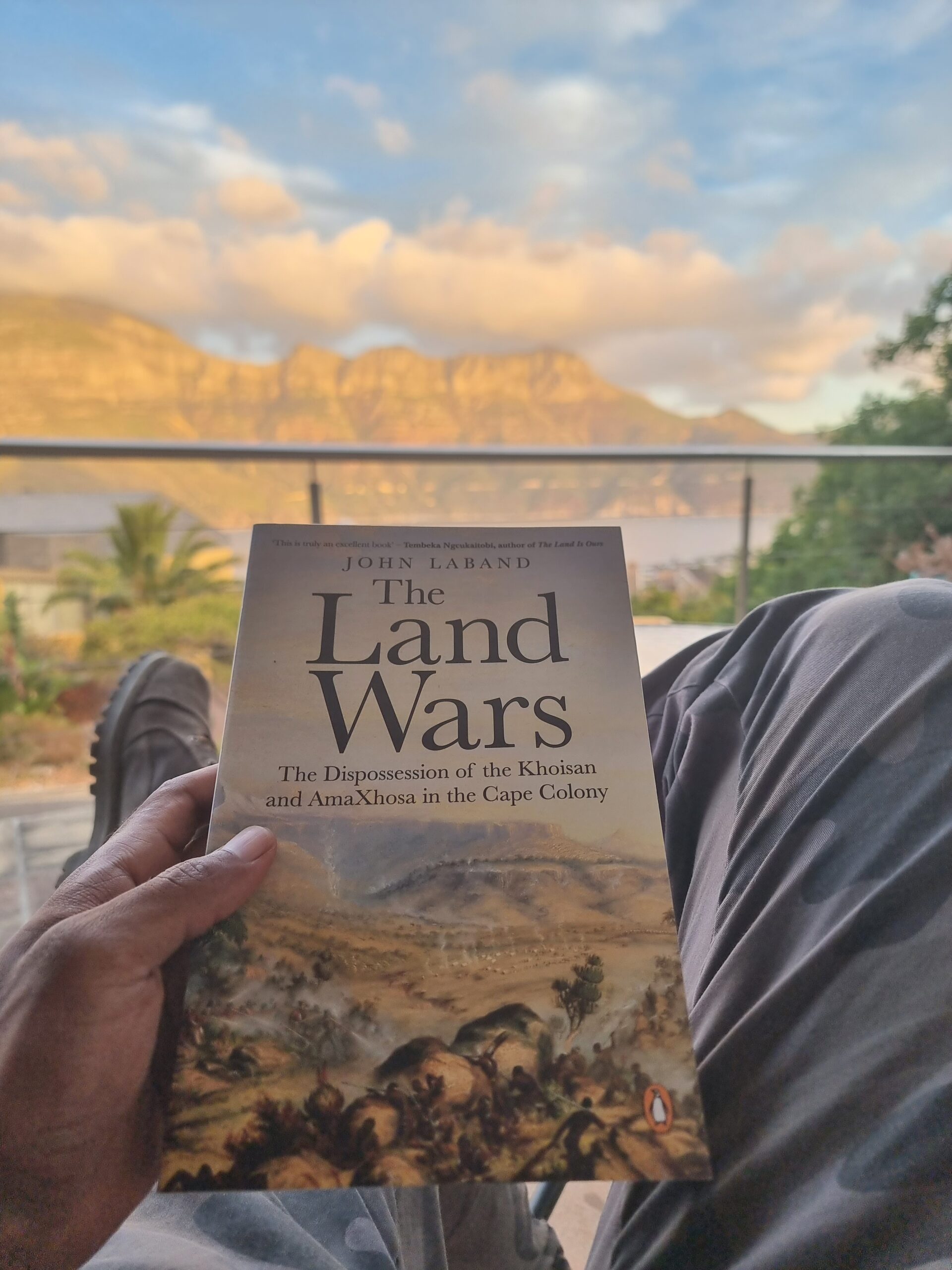~John Laband

Rediscovering My Roots Through John Laband’s “The Land Wars”
Sometimes, a book comes along that not only tells a story but also opens your eyes to a part of history you never fully understood. John Laband’s “The Land Wars” is that kind of book for me. It’s a detailed account of the Eastern Cape frontier wars, and it gave me a much deeper understanding of a time that has shaped South African history in ways that are often oversimplified or ignored entirely. Like I’ve said before, I read good books very slowly and I don’t think I’ve read any book as slowly as I did this one!
A Closer Look at the Eastern Cape Frontier Wars
One of the most interesting things I’ve learned in the book was how the Khoikhoi were integrated into Xhosa society. This isn’t something you hear about much, especially in the South African school system, where history has been dumbed down to the point of reinforcing the idea that apartheid is the only important part of our past. But Laband goes much deeper, exploring the rich and complicated history of the Eastern Cape and how different groups interacted, cooperated, and, at times, clashed.
Another fascinating discovery was the origin of the name “AmaXhosa.” Laband explains that it’s actually of Khoikhoi origin, meaning something like “The people who break things” or “The people who burn or destroy.” This small detail alone opened up a new perspective on how intertwined the histories of these groups are.
Understanding the AmaXhosa Way of Life
Laband also does an excellent job of explaining the AmaXhosa’s way of life. The Xhosa people were pastoralists, moving with their cattle and subsisting on what the land provided. Their lifestyle was deeply connected to the environment, relying on cattle and grain to survive. Reading about this helped me appreciate just how important the land was to them—not just as a place to live, but as a vital part of their culture and survival.
The book also gave me a better understanding of the Gcaleka and Rharhabe clans, their lineage, and their way of life. The Xhosa people had a strong connection to their land, which is why they fought so fiercely to protect it. The Zuurveld, or “Sour Veldt,” with its sour grasses, was a key area for grazing cattle, and the conflicts over this land were not just about territory but about survival.
The Expansion of European Influence
Laband doesn’t shy away from the hard truths about European imperialism in the Eastern Cape. He goes into detail about how the Afrikaners and the English settlers of the 1820s expanded their influence, often at the expense of the local populations. The Afrikaners, who tried to escape British control, found themselves constantly under the thumb of imperial governance. It was interesting to read about the Trekboers, who had a monopoly on the use of Ox-Wagons, the only serious means of transport at the time. These Afrikaner farmers would not only farm their land but also provide transport services, which became essential for settlers moving inland.
One thing that really struck me was my visit to the Voortrekker Monument in Pretoria. It’s a place that has done a great job of preserving history, and it helped me understand the struggles and motivations of the Trekboers and eventually “Voortrekkers” who moved further inland to escape British rule. This visit, combined with the insights from Laband’s book, gave me a clearer picture of the tensions and challenges of that era.
The Brutal Realities of War
Laband’s writing style is straightforward and honest, especially when it comes to the topic of war. He doesn’t shy away from the gruesome details and often uses the language of war with an enthusiasm that shows his deep interest in the subject. The book is filled with vivid descriptions of battles, strategies, and the harsh realities that both the European settlers and the African tribes faced.
One of the most disturbing parts of the book was the story of Chief Hintsa, who was shot in the head during the Sixth Frontier War. After his death, his corpse was treated with a shocking lack of respect, a brutal reminder of the cruelty of that time. Laband also discusses the involvement of Governor D’Urban, who played a significant role in these conflicts, further highlighting the complexities of the wars on the Eastern Frontier.
The Cape Colony’s Struggles and the Great Trek
Laband makes it clear that the Cape Colony was more focused on its central settlements, like the Castle of Good Hope in Cape Town, than on the eastern frontier. This lack of attention and resources made it difficult for the colony to enforce its power over the Xhosa people, leading to repeated conflicts. The Xhosa would return to their homeland after being defeated, and the cycle of conflict would start all over again.
This ongoing tension was a key factor in the Great Trek, where the Trekboers, feeling pushed out and fearing for their lives under British rule, moved further inland. Laband provides detailed insights into what drove this movement, helping me see the world through the eyes of the Afrikaners and understand why they felt they had no choice but to leave.
Personal Reflections: Connecting with My Xhosa Heritage
Reading this book was more than just a history lesson for me; it was a way to connect with my roots. My Xhosa ancestors, who come from different royal clans, were deeply affected by the events described in Laband’s work. The stories of leaders like Sandile, Makhanda, Maqoma, and Sarhili have taken on new significance for me as I trace my lineage back to the days of Tshawe and Cira.
The book also gave me a better understanding of my travels through the Eastern Cape and the Amatole Mountains. Names of roads, towns, and monuments now carry a weight of history that I can appreciate on a deeper level. I see how the events of the past have shaped the present, and I feel a deeper connection to the land and the people who lived here long before me.
The Harsh Realities of Colonialism and Missionaries
Laband doesn’t shy away from the complex and often tragic relationships between the Europeans and the African tribes. The book talks about the Mfengu people, who allied with the Europeans and fought against the AmaXhosa. This alliance earned them territory still known as “Fingoland” today.
The book also explores the sad story of Nongqawuse, the prophetess whose visions led to the cattle-killing movement. Laband hints at the possible influence of Christian missionaries in shaping her beliefs, a theory that, if true, reveals a dark side of colonialism. The devastation that followed nearly destroyed the AmaXhosa people, leaving them in a desperate state.
Conclusion: A Book That Stays with me
“The Land Wars” is a book that stays with you long after you’ve finished reading it. It’s a powerful reminder of the complexities of our history and the many layers that are often overlooked or simplified. Laband’s straightforward and detailed writing style makes the book accessible and engaging, while his enthusiasm for the subject brings the history to life.
For me, this book was more than just a history lesson—it was a journey back to my roots, a way to connect with my heritage, and a profound realization of how the events of those times have shaped the world we live in now. I encourage anyone interested in South African history, especially the history of the Eastern Cape, to read this book. It’s a story of survival, struggle, and the enduring spirit of the people who lived through one of the most tumultuous times in our history.
Other book reviews related to this topic:
